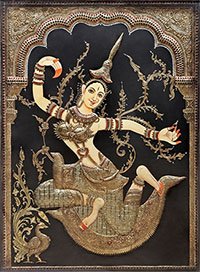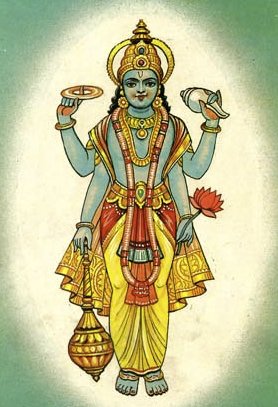Gatagata, Gaṭagaṭa, Gata-agata: 17 definitions
Introduction:
Gatagata means something in Buddhism, Pali, Hinduism, Sanskrit, Jainism, Prakrit, Marathi, Hindi. If you want to know the exact meaning, history, etymology or English translation of this term then check out the descriptions on this page. Add your comment or reference to a book if you want to contribute to this summary article.
Alternative spellings of this word include Gatagat.
In Hinduism
Sports, Arts and Entertainment (wordly enjoyments)
Source: archive.org: Syainika Sastra of Rudradeva with English Translation (art)Gatāgata (गतागत) refers to the “motion (of horses)” (employed in hunting), according to the Śyainika-śāstra: a Sanskrit treatise dealing with the divisions and benefits of Hunting and Hawking, written by Rājā Rudradeva (or Candradeva) in possibly the 13th century.—Accordingly, “Hunting on horseback (āśvina) represents one of the eight subdivisions of Hunting (mṛgayā). [...] But something should be said in brief about hunting, for the diffusion of its knowledge. [...] Five or six horsemen are quite enough for hunting rhinoceros. The horses should be quiet and well-trained in their motion (gatāgata). A horseman should strike the rhinoceros with small darts in quick succession on the back. [...]”.

This section covers the skills and profiencies of the Kalas (“performing arts”) and Shastras (“sciences”) involving ancient Indian traditions of sports, games, arts, entertainment, love-making and other means of wordly enjoyments. Traditionally these topics were dealt with in Sanskrit treatises explaing the philosophy and the justification of enjoying the pleasures of the senses.
Shaivism (Shaiva philosophy)
Source: Manblunder: Detailed Study of Shiva SutrasGatāgata (गतागत) refers to the “movements of prāṇa and apāna”.—Like the active state, dream state also has different levels. The state of dream unfolds when his vikalpas are active in his exclusive world of dreams known as abāhya, his very own internal world. Svapna or dream state has also different combinations. For example, svapna-jāgrat, where the dreamer is able to see his dreams very clearly. This is the active state in dreamy condition. It is because of the movements of prāṇa and apāna are perfectly balanced that his dream appears with clarity. This state is also known as gatāgata, which means going and coming, referring to the movements of prāṇa and apāna.

Shaiva (शैव, śaiva) or Shaivism (śaivism) represents a tradition of Hinduism worshiping Shiva as the supreme being. Closely related to Shaktism, Shaiva literature includes a range of scriptures, including Tantras, while the root of this tradition may be traced back to the ancient Vedas.
Vaishnavism (Vaishava dharma)
Source: Pure Bhakti: Bhagavad-gita (4th edition)Gatāgata (गतागत) refers to “repeated birth and death” (i.e., “repeated going and coming from Earth to heaven”) according to the Śrīmad-Bhagavad-Gītā (verse 9.21).—Accordingly, as Kṛṣṇa says to Arjuna: “[...] [Those who are devoted to fruitive activity as described in the three Vedas worship Me as Indra or other demigods by performing yajña. Having become free from sins by drinking the soma juice, the remnants of the yajña, they pray for entrance into the heavenly planets. When they attain the planet of Indra by virtue of their pious deeds, they enjoy the celestial pleasures of the demigods.] When their pious merit is exhausted, they again fall to the mortal world, having enjoyed the pleasures of the immense celestial realm. In this way, those who desire sense pleasures and who perform fruitive activities as described in the three Vedas receive only repeated birth and death (gatāgata) within this material world”

Vaishnava (वैष्णव, vaiṣṇava) or vaishnavism (vaiṣṇavism) represents a tradition of Hinduism worshipping Vishnu as the supreme Lord. Similar to the Shaktism and Shaivism traditions, Vaishnavism also developed as an individual movement, famous for its exposition of the dashavatara (‘ten avatars of Vishnu’).
In Buddhism
Theravada (major branch of Buddhism)
Source: Google Books: The Great Chronicle of BuddhasGatagata (lit. “wherever one has gone”) refers to one of the “four kinds of offerings to the Sangha”.—The Vinaya Pitaka, the Book of Discipline for members of the Order gives a description of the four categories of offerings made intentionally for the Sangha.—Gatagata-Sanghika refers to offerings which belong to the Sangha of whichever place they (have gone to) have been taken to.
Theravāda is a major branch of Buddhism having the the Pali canon (tipitaka) as their canonical literature, which includes the vinaya-pitaka (monastic rules), the sutta-pitaka (Buddhist sermons) and the abhidhamma-pitaka (philosophy and psychology).
In Jainism
General definition (in Jainism)
Source: The University of Sydney: A study of the Twelve ReflectionsGatāgata (गतागत) refers to “comings and goings” (of sentient beings), according to the 11th century Jñānārṇava, a treatise on Jain Yoga in roughly 2200 Sanskrit verses composed by Śubhacandra.—Accordingly, “In the world of the gods, in the world of men and in the plant and animal world, and also in hell, there is not that womb, not that form, not that place, not that family, there is not that suffering, not any pleasure [and] not that mode wherein these sentient beings are not destroyed by [their] comings and goings [com.—gatāgata] continually”.
Synonyms: Gamanāgamana, Yātāyāta.

Jainism is an Indian religion of Dharma whose doctrine revolves around harmlessness (ahimsa) towards every living being. The two major branches (Digambara and Svetambara) of Jainism stimulate self-control (or, shramana, ‘self-reliance’) and spiritual development through a path of peace for the soul to progess to the ultimate goal.
Languages of India and abroad
Marathi-English dictionary
Source: DDSA: The Molesworth Marathi and English Dictionarygaṭagaṭa (गटगट) [or टां, ṭāṃ].—ad Imit. of the noise made in guzzling or in gulping copiously--v pi: also of the noise of walloping or boiling. v śija, vāja.
--- OR ---
gaṭāgaṭa (गटागट) [or टां, ṭāṃ].—ad gaṭāṭa or ṭāṃ ad Imit. of the sound of a copious or continued gulping, guzzling, or guttling. v pi, khā, giḷa.
--- OR ---
gatāgata (गतागत).—n S Going and coming; reiterated motion gen.
Source: DDSA: The Aryabhusan school dictionary, Marathi-Englishgaṭagaṭa (गटगट) [-gaṭāṃ, -गटां].—ad Imit. of the noise made in gulping copiously.
--- OR ---
gaṭāgaṭa (गटागट) [-ṭā, -टा].—See gaṭagaṭa-ṭāṃ.
Marathi is an Indo-European language having over 70 million native speakers people in (predominantly) Maharashtra India. Marathi, like many other Indo-Aryan languages, evolved from early forms of Prakrit, which itself is a subset of Sanskrit, one of the most ancient languages of the world.
Sanskrit dictionary
Source: DDSA: The practical Sanskrit-English dictionaryGatāgata (गतागत).—
1) going and coming, frequent visits; आदित्यस्य गतागतैरहरहः संक्षीयते जीवितम् (ādityasya gatāgatairaharahaḥ saṃkṣīyate jīvitam) Bhartṛhari 3.7; Bhagavadgītā (Bombay) 9.21; Mu.2.3; 4.1.
2) interchange of place; कष्टं स्मरामि तव तानि गता- गतानि (kaṣṭaṃ smarāmi tava tāni gatā- gatāni) Mālatīmādhava (Bombay) 9.47.
3) the flight of a bird backward and forward.
4) irregular course of the stars (in astronomy).
5) Narration of past and future; स सर्वमखिलं राज्ञो वंशस्याह गतागतम् (sa sarvamakhilaṃ rājño vaṃśasyāha gatāgatam) Rām.7.51.23.
Derivable forms: gatāgatam (गतागतम्).
Gatāgata is a Sanskrit compound consisting of the terms gata and āgata (आगत).
Source: Cologne Digital Sanskrit Dictionaries: Shabda-Sagara Sanskrit-English DictionaryGatāgata (गतागत).—m.
(-taṃ) 1. The flight of a bird backward and forward. 2. Going and coming, reiterated motion in general. E. gata going, āgata coming.
Source: Cologne Digital Sanskrit Dictionaries: Benfey Sanskrit-English DictionaryGatāgata (गतागत).—i. e. gata-ā-gata (vb. gam), n. 1. Going and coming, [Kathāsaritsāgara, (ed. Brockhaus.)] 3, 69. 2. The flight of a bird backward and forward, Mahābhārata 8, 1902.
Source: Cologne Digital Sanskrit Dictionaries: Cappeller Sanskrit-English DictionaryGatāgata (गतागत).—[adjective] going and coming; [neuter] sgl. & [plural] the same as subst.
Source: Cologne Digital Sanskrit Dictionaries: Monier-Williams Sanskrit-English Dictionary1) Gatāgata (गतागत):—[from gata > gam] mfn. ([gana] akṣadyūtādi) going and coming, [Bhāgavata-purāṇa xi, 28, 26]
2) [v.s. ...] n. going and coming, going to and fro, reiterated motion in general, [Bhagavad-gītā ix, 21; Kathāsaritsāgara iii], ([plural]), [iic, cxviii, 119]
3) [v.s. ...] the flight of a bird backward and forward, [Mahābhārata vii, 1902]
4) [v.s. ...] (in [astronomy]) irregular course of the asterisms, [Varāha-mihira’s Bṛhajjātaka]
5) [v.s. ...] appearance and disappearance, growth and decline, [Rāmāyaṇa vii, 51, 24]
6) [v.s. ...] [plural] with √kṛ, to enter into a negotiation or treaty, [Rājataraṅgiṇī viii]
7) [v.s. ...] cf. gamāgama.
Source: Cologne Digital Sanskrit Dictionaries: Yates Sanskrit-English DictionaryGatāgata (गतागत):—[gatā+gata] (taṃ) 1. n. Going and coming; flight of birds.
[Sanskrit to German]
Sanskrit, also spelled संस्कृतम् (saṃskṛtam), is an ancient language of India commonly seen as the grandmother of the Indo-European language family (even English!). Closely allied with Prakrit and Pali, Sanskrit is more exhaustive in both grammar and terms and has the most extensive collection of literature in the world, greatly surpassing its sister-languages Greek and Latin.
Hindi dictionary
Source: DDSA: A practical Hindi-English dictionaryGaṭāgaṭa (गटागट) [Also spelled gatagat]:—adv.) see [gaṭagaṭa].
...
Kannada-English dictionary
Source: Alar: Kannada-English corpusGatāgata (ಗತಾಗತ):—
1) [noun] the act or fact of coming and going.
2) [noun] a long-established custom or practice that has the effect of an unwritten law; a custom.
3) [noun] (dance.) a lifting up of the foot and placing on the ground at the same place, as if in walking.
Kannada is a Dravidian language (as opposed to the Indo-European language family) mainly spoken in the southwestern region of India.
See also (Relevant definitions)
Starts with: Gatagatane, Gatagatanem, Gatagatavanem.
Full-text: Gatagat, Gatagatika, Gatagati, Gatata, Gatanugatika, Gatagatanem, Gamagama, Gata, Kamakama, Kamakamin, Nikulinika, Yatayata, Gamanagamana, Agata, Rac, Kautuka, Thana.
Relevant text
Search found 11 books and stories containing Gatagata, Gaṭagaṭa, Gaṭāgaṭa, Gatāgata, Gata-agata, Gata-āgata; (plurals include: Gatagatas, Gaṭagaṭas, Gaṭāgaṭas, Gatāgatas, agatas, āgatas). You can also click to the full overview containing English textual excerpts. Below are direct links for the most relevant articles:
Gati in Theory and Practice (by Dr. Sujatha Mohan)
Gatis according to Theater < [Chapter 3 - Application of gati in Dṛśya-kāvyas]
The Great Chronicle of Buddhas (by Ven. Mingun Sayadaw)
Four Kinds of Offerings to the Sangha < [Chapter 6 - On Pāramitā]
Mahayana Buddhism and Early Advaita Vedanta (Study) (by Asokan N.)
Bhajana-Rahasya (by Srila Bhaktivinoda Thakura Mahasaya)
Text 16 < [Chapter 4 - Caturtha-yāma-sādhana (Madhyāhna-kālīya-bhajana–ruci-bhajana)]
Shrimad Bhagavad-gita (by Narayana Gosvami)
Verse 9.21 < [Chapter 9 - Rāja-guhya-yoga (Yoga through the most Confidential Knowledge)]
Chaitanya Bhagavata (by Bhumipati Dāsa)
Verse 2.1.240 < [Chapter 1 - The Beginning of the Lord’s Manifestation and His Instructions on Kṛṣṇa-saṅkīrtana]